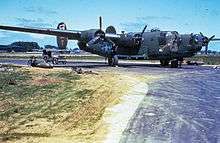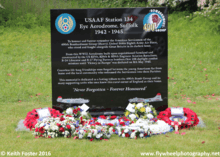490th Bombardment Group
The 490th Bombardment Group is a former United States Army Air Forces unit. The group was activated in October 1943 . After training in the United States, it deployed to the European Theater of Operations and participated in the strategic bombing campaign against Germany from 31 May 1944 to 20 April 1945, losing 22 aircraft while flying more than 5,000 sorties. Following V-E Day, the group returned to the United States, where it was inactivated in November 1945.
| 490th Bombardment Group | |
|---|---|
 490th Bombardment Group B-17G Flying Fortresses in formation during a mission | |
| Active | 1943–1945 |
| Country | |
| Branch | United States Army Air Forces |
| Role | Bombardment |
| Part of | Eighth Air Force |
| Engagements | European Theater of Operations |
| Insignia | |
| Tail Code[1][note 1] | Square T |
History
World War II
![]()

The 490th Bombardment Group was activated at Salt Lake City Army Air Base, Utah on 1 October 1943, with four squadrons, the 848th, 849th, 850th and 851st Bombardment Squadrons assigned. The 848th through 850th Squadrons were activated with the group at Salt Lake City, while the 851st, a former antisubmarine squadron that provided the group's cadre, was located at Mountain Home Army Air Field, Idaho.[2][3][4][5][6]
In December, group headquarters and the three squadrons at Salt Lake City moved to Mountain Home, where they began training with Consolidated B-24 Liberators. The squadrons left their training base on 9 April 1944 for the European Theater of Operations. The group's ground echelon departed the Port of Embarkation at Camp Shanks, New York, sailing on the SS Nieuw Amsterdam on 11 April and arriving in the United Kingdom on 25 April. The air echelon flew its planes along the southern ferry route beginning on 12 April.[7]
The group arrived at RAF Eye, its combat station, on 28 April.[2] However, before the group could fly its first combat mission, the 850th Squadron was reassigned to VIII Air Force Composite Command to fly Operation Carpetbagger missions with the 801st Bombardment Group (Provisional).[8] The remaining three squadrons of the group began combat operations on 31 May 1944. The group's initial missions were flown to prepare for Operation Overlord, the invasion of Normandy, as the squadron concentrated on targets in France. It supported the landings on D-Day and attacked coastal defenses, airfields, rail lines and vehicles near the landings. It flew close air support missions to assist British forces near Caen in July and American forces near Brest in September. It was withdrawn from combat on 6 August 1944, to convert to the Boeing B-17 Flying Fortress as the 93d Combat Bombardment Wing transitioned to make the 3d Bombardment Division an all B-17 unit.[2][7] While the group was transitioning aircraft, the 492d Bombardment Group replaced the 801st Group in the Carpetbagger mission on 12 August. The 850th Squadron transferred its crews and B-24s to the 492d Group, and returned to the 490th on paper to be included in the change to the group's new bomber.[2][9]
Once transition to the B-17 was completed on 24 August, the squadron concentrated on strategic bombing, attacking oil refineries, airfields, marshalling yards, and factories manufacturing aircraft and armored vehicles.[2] It participated in raids against Berlin, Cologne, Hamburg, Hanover, Kassel, Merseburg and Münster.[2] The 490th flew its first mission with the B-17 on 27 August to Genshagen, Germany to attack the BMW engine factory although the mission was aborted due to weather.[10] On occasion, the squadron was diverted from the strategic bombing campaign. It attacked enemy lines of communication during the Battle of the Bulge from December 1944 through January 1945. In the last month of the war in Europe, it carried out interdiction missions to support advancing ground forces.[2] The squadron's last combat mission was flown on 20 April 1945.[7]
Following V-E Day, the squadron carried food to flooded areas of the Netherlands and transported prisoners of war to Allied repatriation centers.[2] The air echelon began flying its planes back to the United States on 6 July 1945. The ground echelon sailed from Southampton on the RMS Queen Elizabeth on 26 August 1945.[7] The unit regrouped at Drew Field, Florida in September. It was inactivated there on 7 November 1945.[2]
Memorial

A permanent memorial, situated near the old fuel dump on RAF Eye, was dedicated to the 490th Bombardment Group on 29 May 2016, in front of families of 490th veterans, current serving USAF personnel, and guest of honor, 490th veteran, Si Spiegel.[11]
Lineage
- Constituted as the 490th Bombardment Group (Heavy) on 14 September 1943
- Activated on 1 October 1943
- Redesignated 490th Bombardment Group, Heavy c. 1944
- Inactivated on 7 November 1945[2]
Assignments
- II Bomber Command, 1 October 1943
- Second Air Force, 6 October 1943
- 93d Combat Bombardment Wing, 7 April 1944[7]
- 13th Combat Bombardment Wing (later 13th Bombardment Wing), March 1945–c. 26 August 1945[12]
- III Bomber Command, 3 September-7 November 1945
Components
Stations
Aircraft
- Consolidated B-24 Liberator, 1943–1944
- Boeing B-17 Flying Fortress, 1944–1945[2]
Campaigns
| Campaign Streamer | Campaign | Dates | Notes |
|---|---|---|---|
| Air Offensive, Europe | 28 April 1944 – 5 June 1944 | 490th Bombardment Group[2] | |
| Air Combat, EAME Theater | 28 April 1944 – 11 May 1945 | 490th Bombardment Group[2] | |
| Normandy | 6 June 1944 – 24 July 1944 | 490th Bombardment Group[2] | |
| Northern France | 25 July 1944 – 14 September 1944 | 490th Bombardment Group[2] | |
| Rhineland | 15 September 1944 – 21 March 1945 | 490th Bombardment Group[2] | |
| Ardennes-Alsace | 16 December 1944 – 25 January 1945 | 490th Bombardment Group[2] | |
| Central Europe | 22 March 1944 – 21 May 1945 | 490th Bombardment Group[2] |
Notable Members
- Howard Zinn, democratic socialist and historian.
- Ken Kavanaugh, American football player, coach, and scout.
See also
References
Notes
- Explanatory notes
- The square was white on the group's original camouflaged B-24s. Replacements in natural metal displayed a black square . The tail code was replaced by high visibility red tail markings on group B-24s before the unit converted to B-17's and continued on the Flying Fortresses. Watkins pp. 116–117.
- Citations
- Maurer, Combat Units, pp. 359–360
- Maurer, Combat Squadrons, p. 780
- Maurer, Combat Squadrons, pp. 780–781
- Maurer, Combat Squadrons, p. 781
- Maurer, Combat Squadrons, pp. 781–782
- Freeman, p. 261
- Freeman, p. 263
- Freeman, pp. 261, 263
- Air Force Historical Research Agency, Microfilm CD B0650 p. 813
- Plew, TSG Matthew (1 June 2016). "490th Bomb Group Memorial unveiled". 48th Fighter Wing Public Affairs. Retrieved 5 November 2018.
- "Factsheet 13 Strategic Missile Division". Air Force Historical Research Agency. 4 October 2007. Archived from the original on 30 October 2012. Retrieved 6 April 2014.
- See Maurer, Combat Squadrons, pp. 789–781 (departure date for component squadrons).
- Station number in Anderson.
- Station information in Maurer, Combat Units, pp. 359–360, except as noted.
Bibliography
![]()
- Air Force Historical Research Agency (1943–1945) Microfilm reels B0649 & B0650 "History of the 490th BG"
- Anderson, Capt. Barry (1985). Army Air Forces Stations: A Guide to the Stations Where U.S. Army Air Forces Personnel Served in the United Kingdom During World War II (PDF). Maxwell AFB, AL: Research Division, USAF Historical Research Center. Archived from the original (PDF) on 23 January 2016. Retrieved 28 June 2017.
- Freeman, Roger A. (1970). The Mighty Eighth: Units, Men and Machines (A History of the US 8th Army Air Force). London, England, UK: Macdonald and Company. ISBN 978-0-87938-638-2.
- Freeman, Roger A. (1978). Airfields of the Eighth: Then and Now. Harlow, England: After the Battle. ISBN 0-900913-09-6.
- Maurer, Maurer, ed. (1983) [1961]. Air Force Combat Units of World War II (PDF) (reprint ed.). Washington, DC: Office of Air Force History. ISBN 0-912799-02-1. LCCN 61060979. Retrieved 17 December 2016.
- Maurer, Maurer, ed. (1982) [1969]. Combat Squadrons of the Air Force, World War II (PDF) (reprint ed.). Washington, DC: Office of Air Force History. ISBN 0-405-12194-6. LCCN 70605402. OCLC 72556.
